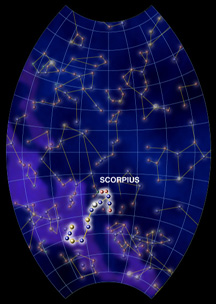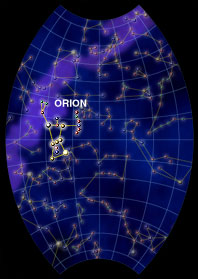The Constellation Sagittarius, the Archer
Click on image for full size
Sagittarius
Sagittarius is a centaur, with the torso of a man atop the body of a
horse. Unlike the wise and peaceful centaur Chiron (
Centaurus),
Sagittarius is aiming his giant bow at his neighbor,
Scorpius. While this is a very large
constellation, its stars are relatively faint and most people easily
recognize just the central figure which resembles a teapot with a
lid, handle, and spout.
More than a dozen objects reside in Sagittarius, including globular clusters. Recently,
astronomers have discovered a small galaxy in Sagittarius that is
crashing through the Milky Way.
Exactly who is Sagittarius? The Mediterranean people viewed him as Enkidu,
the close friend of Gilgamesh, believed to be represented by Orion.
Greek mythology associates Sagittarius with Crotus, the son of the
goat-god Pan and Eupheme, the nurse of the Muses. He grew to be a
skilled hunter, as well as a man with an artistic soul. The Muses,
with whom he was raised, begged Zeus to honor him with a constellation
equal to his great talents.
You might also be interested in:

How did life evolve on Earth? The answer to this question can help us understand our past and prepare for our future. Although evolution provides credible and reliable answers, polls show that many people turn away from science, seeking other explanations with which they are more comfortable.
...more
More than any other constellation, Scorpius resembles its given name. If you live in the northern hemisphere of the Earth, Scorpius crawls across the southern sky, close to the horizon. But if you live
...more
Orion, the Hunter, is by far the most famous seasonal constellation. No other is more distinct or bright as this northern winter constellation. The famous Orion's Belt makes the hunter easy to find in
...more
In Greek mythology, Zeus (Jupiter in Roman mythology) was the king of heaven and Earth and of all the Olympian gods. He was also known as the god of justice. He was named king of the gods in the special
...more
Aquila, the celestial eagle, is one of the three constellations which have bright stars forming the Summer Triangle. A nearly perfectly straight line of three stars symbolizes part of the wings. The center
...more
Cygnus, the Swan, is also known as the Northern Cross because of its shape. The tail of the swan is marked by the bright star Deneb, Arabic for "tail". Three fainter stars cross the line between Deneb
...more
Hercules, the great Greek warrior, can be seen kneeling in the sky for northern latitudes throughout the Spring months. Hercules first becomes visible in the east in April, and works his way high across
...more
Lyra, the Lyre, is a type of small harp held in the player's lap. The brightest star in Lyra, Vega, is placed in the handle of the harp. A small parallelogram of four faint stars just to the southeast
...more















